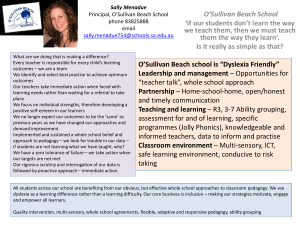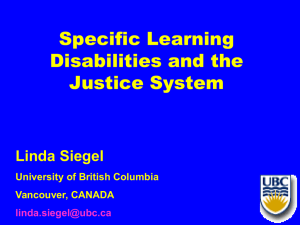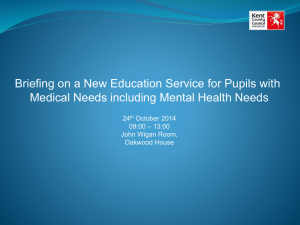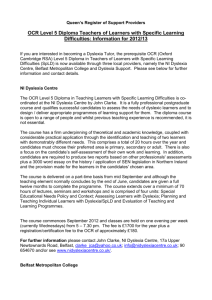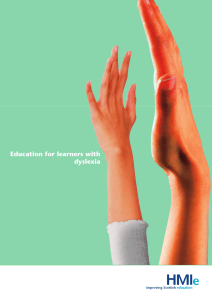Supporting pupils with dyslexia in mainstream classrooms
advertisement
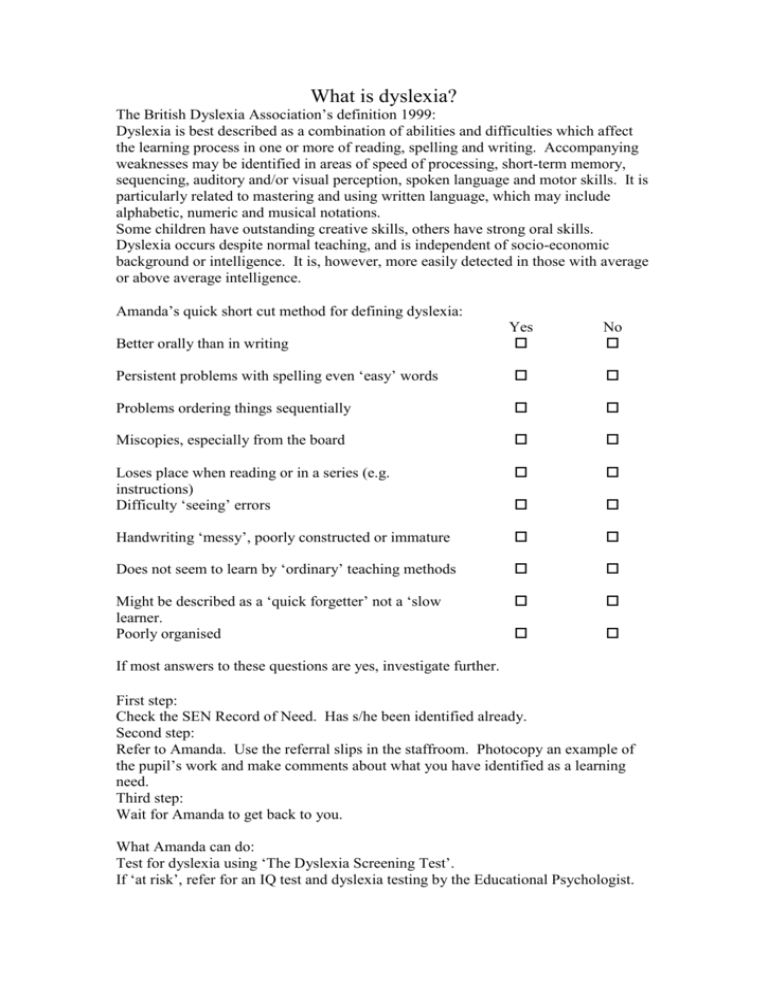
What is dyslexia? The British Dyslexia Association’s definition 1999: Dyslexia is best described as a combination of abilities and difficulties which affect the learning process in one or more of reading, spelling and writing. Accompanying weaknesses may be identified in areas of speed of processing, short-term memory, sequencing, auditory and/or visual perception, spoken language and motor skills. It is particularly related to mastering and using written language, which may include alphabetic, numeric and musical notations. Some children have outstanding creative skills, others have strong oral skills. Dyslexia occurs despite normal teaching, and is independent of socio-economic background or intelligence. It is, however, more easily detected in those with average or above average intelligence. Amanda’s quick short cut method for defining dyslexia: Yes No Persistent problems with spelling even ‘easy’ words Problems ordering things sequentially Miscopies, especially from the board Loses place when reading or in a series (e.g. instructions) Difficulty ‘seeing’ errors Handwriting ‘messy’, poorly constructed or immature Does not seem to learn by ‘ordinary’ teaching methods Might be described as a ‘quick forgetter’ not a ‘slow learner. Poorly organised Better orally than in writing If most answers to these questions are yes, investigate further. First step: Check the SEN Record of Need. Has s/he been identified already. Second step: Refer to Amanda. Use the referral slips in the staffroom. Photocopy an example of the pupil’s work and make comments about what you have identified as a learning need. Third step: Wait for Amanda to get back to you. What Amanda can do: Test for dyslexia using ‘The Dyslexia Screening Test’. If ‘at risk’, refer for an IQ test and dyslexia testing by the Educational Psychologist. Supporting pupils with dyslexia in mainstream classrooms. General: Raise pupils’ self esteem. Reward what can be achieved. This is the single most important factor in achievement according to pupils themselves. Use the information supplied in the IEP if the pupil has one. The SENCO will have assessed the pupil and prioritised what needs to be learned. Give two instructions at a time. Ask pupils to repeat instructions to you. Repeat instructions until s/he can repeat them back. Allow more time for tasks such as getting out books, getting started, completing work. This includes practical tasks. Reading: Do not ask pupils to read aloud without preparation. Teach unfamiliar subject words. Help with study skills such as skimming, scanning, selecting key words. It helps if teachers’ handwriting is legible and worksheets are typed! Spelling: Mark written work on content and encourage the use of a wide vocabulary. Correct only a few errors. Do not cover work in red ink. Teach the spelling of subject specific words. Do not overload pupils. Give all pupils a list of subject specific words to be stuck into their exercise books for reference. Have lists of subject specific words on display in teaching rooms. Allow the pupil to read work back to you if you cannot read it. Written work: Encourage legible handwriting but do not expect it to change. Do not ask for work to be written out again unless it is much worse than usual. Either give more time, or photocopy notes from another pupil or a ‘parallel’ book kept by a TA. Accept less written work. Assessment: Assess through oral responses. When setting long responses, use writing frames. Ways of assessing understanding without too much writing: Matching questions to answers. True/false statements. Sentence matching (‘tops and tails’) Multiple choice. Labelling diagrams. Categorising. Table/grid completion. Title – paragraph match. Choosing a précis. Sentence completion. Sequencing. Left brain and right brain functions: Left brain functions Right brain functions Uses logic Uses feeling Detail oriented “Big picture” oriented Facts rule Imagination rules Words and language Symbols and pictures Present and past Present and future Maths and science Philosophy and religion Can comprehend Can “get it” (i.e. meaning) Knowing Believing Knows object name Knows object function Forms strategies Presents possibilities Practical Impetuous Safe Risk taking We all use both sides of our brains. Most people are ‘left brained’. Dyslexics are ‘right brained’. ‘Right brain’ learning strategies: Use: Imagery Music Drawing Visual-spatial patterns Humour Empathy Intuition Encourage sensory exploration and ‘hands on’ activities Develop visualisation skills Encourage imagination Multi-sensory learning. Most people have a dominant learning style: Auditory learners Kinaesthetic learners Visual learners 20 – 30% of school age children remember what is heard 30 – 40 % of school age children remember when they use their hands or whole body to learn. 40 % of school age children remember what is seen. Talk to themselves Mouth words Like speeches/singing Tell jokes Prefer verbal instructions Easily distracted by noise Listen well Like lectures Enjoy rhythm and rhyme Remember by listening Recall conversations Use talk well Spell out loud Auditory learners say: “That rings a bell” “Sounds great to me” Like physical activity Move a lot Make and/or alter things Remember by doing Like action words Use gestures Fidget Like close proximity Need to visit a place to remember it Kinaesthetic learners say: “Let’s tackle the issue” “Run that by me” “I’ll handle that” Neat and tidy workplace Like tidy work Plan ahead Like detail Like to look good Like simile and metaphor Like pictorial lessons Don’t listen well Day dream often Like an overall view Draw, scribble, doodle Prefer images to words Visual learners say: “That looks right to me” “I can see what you mean” “I can picture the scene” Addressing different learning styles in lessons: Auditory learners Explain Repeat Discuss Use tapes Use poems Tell stories Use dialogue Use drama Read aloud Kinaesthetic learners Be practical Use three dimensional models Make things Use tactile experience Move about Write Visual learners Use pictures Use diagrams Use colour coding Use highlighting Use handouts Do practical demonstrations




